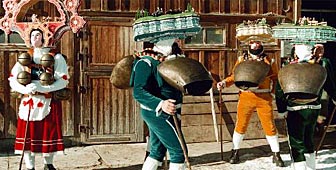Dressing up for January customs

From Basel to St Moritz, January is a time for the Swiss to celebrate odd customs, as they have for centuries.
The highlight of the social calendar in the Upper Engadine is the “Schlitteda” -a procession of traditional horse-drawn sleighs.
Sleighs were once the main means of transport in the Engadine, and in the 18th and 19th centuries were an integral part of the courting ritual.
Men dressed in tails and top hats, take care of the steering from the back of small narrow sleighs, which are colourfully painted with flowers or the family coat of arms.
The women, wearing traditional hand-sewn costumes, sit in the front seat where they can best display their bright red dresses. Even the horses are fitted out in decorative harnesses and sleigh bells.
The procession begins in the first weekend of January in the village of Pontresina before being repeated in the other villages in the valley, including St Moritz, over the following weekends in the month.
Savage antics
On January 12 in Basel, residents and tourists will once again flock to the banks of the Rhine River in anticipation of the arrival of a savage known as the “wild man”.
Once a year, the wild man comes to help the people of Lesser Basel get revenge on their neighbours in Greater Basel.
The costumed figure travels on a raft performing a wild dance, repeatedly showing his backside to the people in Greater Basel.
Many believe his antics are revenge for the “Lällekeenig” (tongue king) figure, which sticks its tongue out at Lesser Basel, day in and day out, from its position on Greater Basel’s side of the river.
But the event is the annual highlight of a centuries’ old rivalry between the people belonging to the traditional working class on the right bank and the merchants, traders and craftsmen of Greater Basel.
Around mid-morning, the wild man comes ashore in Lesser Basel and is welcomed by two other costumed characters, the griffin and the lion. There’s a gun salute before the three set off through the streets of Lesser Basel, dancing and performing age-old rituals.
The “old” New Year
In Appenzell in the northeast, the New Year starts 13 days later than in the rest of the country. It’s ushered in by groups of strangely dressed wanderers who traipse through the countryside, yodelling for money.
The 200-year-old custom practiced in parts of canton Appenzell-Ausserhoden is known as “Silvesterkläuse” and takes place on January 13 – New Year’s Eve, according to the old Julian calendar.
The groups of costumed men gather at dawn to begin their walk through the countryside. They all wear masks and folk costumes – some dress as women – and amble from farm to farm, announcing their approach with cowbells that hang heavily from their fronts and backs.
At each stop, the group of Silvesterkläuse lure people out of their houses with traditional yodelling, wish everyone a happy new year, and are offered drinks and money in return.
The Appenzell Customs Museum (Museum für Appenzeller Brauchtum) in the town of Urnäsch houses a permanent collection of Silvesterkläuse masks and bonnets.
swissinfo

In compliance with the JTI standards
More: SWI swissinfo.ch certified by the Journalism Trust Initiative
You can find an overview of ongoing debates with our journalists here . Please join us!
If you want to start a conversation about a topic raised in this article or want to report factual errors, email us at english@swissinfo.ch.